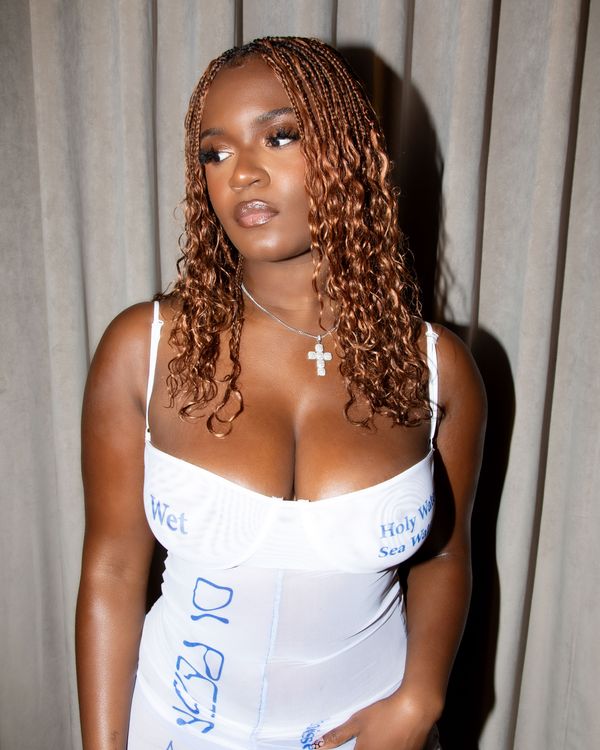
This article was published on June 12, 2023. Roses are red, tears are blue – A Fountain Baby Extended Play, is out June 28, 2024.
Amaarae plays the role of a material girl in her music. In her cinematic sophomore album, Fountain Baby, her signature airy whisper swirls over tales of money and counterfeit bags, seduction and thwarted love. The formerly Ghana-based artist, whose real name is Ama Serwah Genfi, grew up between Atlanta and Accra and pulls influences from both places — a heady concoction of string and harp instrumentals, aughts hip-hop bravado, and Afrobeat rhythm. Her 2020 debut album The Angel You Don’t Know cemented her simultaneously as an American pop artist to watch (most recently, her song “A Body, a Coffin” was featured on the Black Panther: Wakanda Forever soundtrack) and the face of an emerging Ghanian alté scene within the already influential West African alté genre.
Amaarae’s first album was feature heavy — artists like Nigerian singer-songwriter Odunsi (the Engine) and fellow Ghanaian American vocalist Moliy contributed to its futuristic, Afro-fusion sound. Fountain Baby, however, has none. “Coming off of my last album, because I had so many features, people thought that I couldn’t carry songs by myself,” she says. “What they failed to understand is that I was A&R-ing all of those songs on my own, putting the beats together, picking producers and features. So this time I was like, ‘All right, I’m going to do everything myself.” She’s also leaning more pop this time. “Obviously Afrobeats is experiencing a huge wave that has helped me and a lot of artists,” she says, “but I want the freedom of the vision that exists outside of this pocket.” In order to create Fountain Baby, she became an obsessive pop scholar. “I have a playlist called ‘Album Two’ of all of my favorite songs that I studied over and over again,” she says. Studying songs like Madonna’s “Give It to Me” or Janet Jackson’s “Someone to Call My Lover” helped her accumulate an encyclopedia of technical references she brings to her new songs. “Princess Going Digital” retools the nostalgic call-and-response of a Nelly or Fabolous joint to detail the push and pull of a modern romance. Pop earworm “Sociopathic Dance Queen” has a magnetic dance-floor insistency reminiscent of Robyn’s “Honey.” Here, Amaarae breaks down all the influences that shaped her new album.
Britney Spears, Blackout
The first time I heard Blackout was when I was 14. I was at a party at my friend Alexa’s house in New Jersey, where I lived at that time. I’ll literally never forget it. I fucked with Gimme More but had never heard the album all the way through. The way this house party of teens was dancing — I have never seen anything like that.
From Britney, I learned about two things — one is intentionality with production choices. For me, that is really clear on Blackout. The choices on that album are so bold and boisterous, taking from the kind of techno at the time and urban pop. I really wanted to inject that into my music. The second thing I learned from Britney was vocal tone — her control and texture. Britney has one of the most interesting textures in the world. And because it’s such a unique texture, people think she’s not coloring with her voice, but there’s these miniature dynamics in the way that she works her voice that I really took away from this album.
I learned from Michael and Janet Jackson in that regard, too. The melodic influence of Off the Wall and the sexiness and confidence of Velvet Rope are elements I bring a lot to my own performance. When you have a light voice, people think you can only sing in one type of way. But I learned from Janet and Michael there’s so many different ways to color voice even when you work in a limited vocal range.
A Recent Relationship
Fountain Baby is about romance, and it is inspired by one person in particular — my most recent relationship. This was a person that came into my life at the right time and gave me the push that I needed to step outside of myself and face fear. I was falling in and out of love and I was scared out of my mind. But I think not denying those feelings is what led me to a lot of the songs on Fountain Baby. You can find this in a lot of the songwriting — the bars are endless when it comes to love. The whole second verse of “Reckless & Sweet” is a favorite. “Wasted Eyes”: “Demon with the Dior in the dresser” and “Hottie million with a milli on me, I wanna ménage with the blicky on me” — there’s a lot of paranoia and anxiety in these bars but there’s still a strong desire for the subject here. Also in “Angels in Tibet”: “Louvre and Armani, I like how you say it,” I think that was just a sexy, clever way to say, “I love the way you speak.”
Stevie Nicks, Young Thug, Gucci Mane, and Anthony Kiedis
They’re all pretty disparate, and they’ve all influenced my voice. There is a very slight undertone of raspiness to my voice and that’s definitely from Anthony Kiedis. As for the high-pitched pierce, that’s Young Thug. I see Gucci in myself less so in the vocal texture but in the wittiness I try to bring to my lyrics. And Stevie Nicks comes out in, like, the vulnerability and the type of expression that I like.
Nelly’s “Hot in Here” (and Other Club Hits)
I like the way I used to see songs portrayed in the club. I think about Nelly’s “Hot in Here” or LL Cool J’s “Headsprung” — probably from 2002 to 2005, all the best videos and songs were in the club. I think that era was the height of entertainment, and not entertainment as a tool to make people stupid, but as a tool to keep people going. There were actors and actresses that made certain types of movies that either made you laugh, made you sad, made you cry, made you happy, whatever. But that was their sole job. And whoever was doing it was the best. Same thing with music. And I just want us to go back to that. With this album, I wanted to take listeners back to dancing to interesting beats in the club. I made “Princess Going Digital” with the full intention of wanting to shift the style of music that’s being played on the dance floor. So when people are listening to this, I hope the music makes them envision themselves being in the club and dancing to something that they wouldn’t expect themselves to dance to.
The Clipse, Hell Hath No Fury
I learned how to be ballsy with production from Hell Hath No Fury. Pharrell and Chad Hugo, who produced it, as well as the Clipse, as rappers, chose very interesting instruments, and drew from very interesting cultures. One of the biggest cultures I think they drew from was Japanese culture (probably because of Nigo’s influence on them). Some elements they incorporated were homegrown instruments like the kora or traditional ways of singing where they use their throat.
We have a song called “Wasted Eyes,” and it begins with a sample of a song called “Battaki” by Umeko Ando, who is a Japanese folk singer. For the first two bars of the song, Ando is playing this tune on the kora. Instead of sampling the record, I was like, “All right, cool. What if we had a kora player come in?” And she played the undertone of the original song. Then we had a Japanese singer, Crystal Kay, come in and play the top line. I was like, “Crystal, I want you just to sing this top line. But I want you to switch up the lyrics so it’s in line with the topic of the song itself.” So in “Wasted Eyes” she’s singing in Japanese, “Time to play or not to play. What am I going to choose: play, play, play.” That was how we learned to resample. It was the most challenging record to make. As far as production, we really pushed ourselves.
Dream Wife, So When You Gonna …
I am a huge fan of the Raincoats, this post-punk girl group from the ’70’s I first discovered when I went on a deep dive researching Kurt Cobain’s influences. They embody this all-girl group energy I really like. I ended up loving them so much I interviewed them for a radio show with NTS. So when I first heard this song, I was immediately drawn to it because I heard so much of the Raincoats in it. Dream Wife DM’ed me about potentially collaborating, and I jumped at the chance. They play guitar on the song “Sex, Violence, Suicide.” The song itself is an interesting combination because it’s them playing over a beat by this Nigerian kid, Tochi Bedford, who was DM’ing me his beats. I loved how expansive his sound was and how daring he was in sending me interesting music. With “Sex, Violence, Suicide,” I told him I’d been listening to a lot of the Raincoats, Smashing Pumpkins, the Vaselines, and Dream Wife, and I wanted to make a song in that space. He went away with the feedback and came back the next day with a folder full of demos he programmed on his laptop and had his friend Dara play guitar over! I’d never heard him do any rock-leaning sounds before. I loved how willing he was to push himself in new ways.




